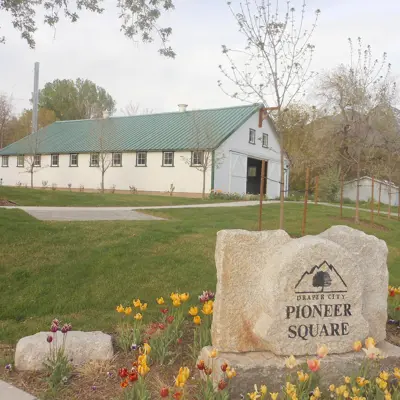Day Dairy Barn

The Day Dairy Farm was originally part of a large homestead that was divided among the descendants of pioneer settler Henry Eastman Day.
In the spring of 1850, Henry Eastman Day crossed the plains, arriving in Salt Lake City on July 2, 1850, and in Draper later that fall. Once the snow melted off the mountains the next spring, Henry was able to access the timbers needed to build a new home. He established a home and farm on 120 acres of land, helped build the community, and was baptized into the Latter-day Saint faith. Henry married Leah Rawlins on January 2, 1852. Their home, one of the first adobe homes built in Draper, still stands near 300 East.
Later, Henry entered into polygamy, becoming a husband to three wives and father to eighteen children, one of whom was Elias John Day. In the early 1890s, Elias John and his wife Olive established a farm on the Day land, raising their family in a log home on the property. In the early 1920s, the log home burned and Elias John built a prairie-style bungalow to the northeast of where the cabin once stood. Elias John, known for his kindness to people and animals, managed the farm with the help of his sons until the Great Depression threatened the livelihood of so many in Draper. One of Elias’ sons, Harmon Eastman Day, took over the farm in the early 1930s and managed to keep it afloat with a series of sugar beet crops. Harmon’s children remember their father driving his complement of seven or eight stock cows down the road during difficult times so the cows could eat the grass growing along the side.
In 1934, Harmon and his wife Phoebe moved into the brick home on the property and, with the help of their ten children, built a productive dairy farm that became a regional standard for modern, efficient agricultural practice. In addition to raising hay, grain, and sugar beets, Harmon built an outstanding herd of registered Holstein cattle. He was a leader in the farming community, serving as a member of the Farm Bureau, a board member of the Milk Producers Association, and director of the East Jordan Irrigation Canal. Harmon’s sons, Elias John (Jack) and Henry McConnell Day took over the farm when their father died in 1965. They continued in their father's tradition and maintained one of the top purebred Holstein herds in the nation. In 1987, they were honored as Utah's Holstein Breeder of the Year at the Utah Dairy Convention. Jack passed away in 1987 and Henry continued to operate the dairy with his son, relocating the herd to Payson and selling the land farmed by three generations of Days.
Years ago, granddaughter Chrisanne Sueltz purchased the Harmon and Phoebe Day bungalow, lovingly renovated it, and relocated her salon, Studio 603, to the charming house. She won a Draper City award for Outstanding Adaptive Reuse of the historic property. Unfortunately, the bungalow was torn down in 2017. Like the Harmon and Phoebe Day bungalow, the large white dairy barn on the former Day property dates to the early 1920s and was built by Elias John with the help of his sons and Eugene Vawdrey. The historic shiplap-sided wood barn is a rare reminder of Draper’s rich agricultural history.
In 2010, the Day Barn was moved to Draper City Park. The barn’s interior was remodeled and renovated to include new footings and foundation. The barn is a 2,087-square-foot space and is a venue available for events through Draper City’s Parks and Recreation Department.
The residential and commercial development that now sits where the Day Dairy Farm was is known as the Village Shoppes at Day Dairy. The City also boasts a neighborhood in the South Mountain Community with streets named after the original Day family: Henry, Leah, Caroline, and Elizabeth. The Day family has left their mark on Draper City. The Day Barn serves as a reminder of Draper’s agricultural history while providing space for the community to come together and celebrate the present.
The Day Barn is available to rent for events. See the video below for a tour.
